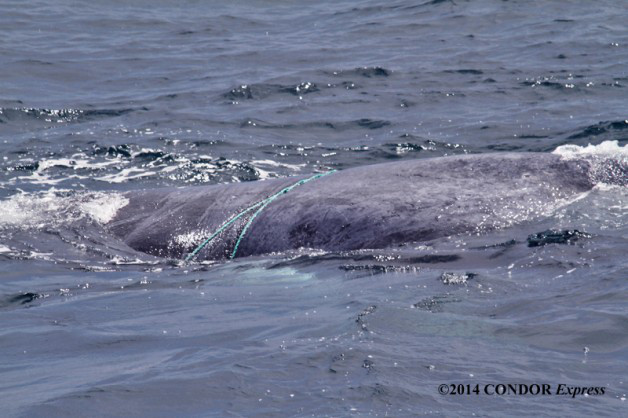Team of Experts Save Entangled Humpback Whale
Whale Caught on Fishing Gear Attached to Traps

A humpback whale was saved from a life-threatening rope tangle after a seven-hour rescue near the north shore of Santa Cruz Island on June 6. Captain Dave Beezer and his crew aboard the Condor Express saw a plethora of blue and humpback whales on a whale-watching tour last Thursday evening, but as they concluded the trip, Beezer noticed something unusual about one particular creature. With a boatful of worried passengers, they followed the massive mammal and found it was tangled in fishing rope, circling it a couple of times around its middle and hog-tying its tail flukes. “All it could do was slowly swim in small circles,” explained Beezer.
“Every entanglement is completely different,” Beezer said. “It’s rare that you see two that are similar.” This whale was fairly stationary because it was anchored to the ocean floor, 700 feet down. But it was almost entirely trapped and had just enough mobility to raise its head enough to expose its blowholes to breathe. (A few weeks ago, a rescue crew tracked a similarly entangled whale for nearly 700 miles and two-and-a-half weeks.)
Knowing the animal would likely die without assistance, Beezer contacted the right people — Channel Islands Marine & Wildlife Institute (CIMWI), which operates under the National Oceanic and Atmospheric Administration (NOAA) — and a whale entanglement team (WET) of six took off with a small rescue boat, the right equipment, and necessary permits at 7 a.m. the next morning.
Once they arrived at the scene around 8:15 a.m., the rescue team noticed the ropes that the whale was caught in were attached to a surface float that was marked with commercial fishing gear numbers. They ran the digits through the Department of Fish and Wildlife service and contacted the fisherman who owned the gear. “The fisherman was extremely cooperative,” Beezer said, explaining that he was able to provide important information about the specifics of the gear — the tangled line was attached to several traps used to capture prawns. Because of a GPS connected to the fishing gear, they discovered the whale had actually moved two miles. “It’s a lose-lose situation,” said Beezer. “These fishermen don’t want to harm these animals. They certainty don’t want to lose the gear. They definitely aren’t the bad guys.”
The team spent several hours observing the whale’s situation, with swarms of dolphins and sea lions surrounding them and the whale making loud trumpeting noises and thrashing its tail. Eventually a V-shaped knife attached to a carbon-fiber pole freed the whale, and the exhausted creature regained strength and swam away 15 minutes later.
“It’s a team effort,” said Beezer. “You have to involve Sea World, local fishermen, the local sanctuary, the Fish and Game Department, and National Park Services.” NOAA requires specialized training — more than someone in a scuba suit and a dive knife. “Tarzan would not qualify,” wrote Condor Express spokesperson Bob Perry at the Condor‘s website.



